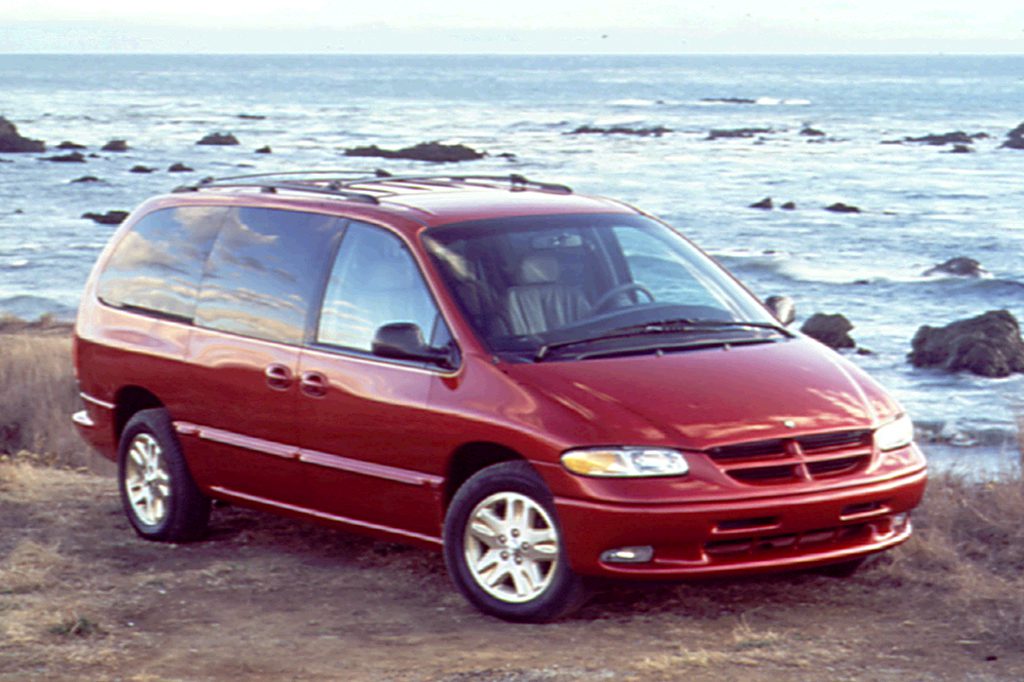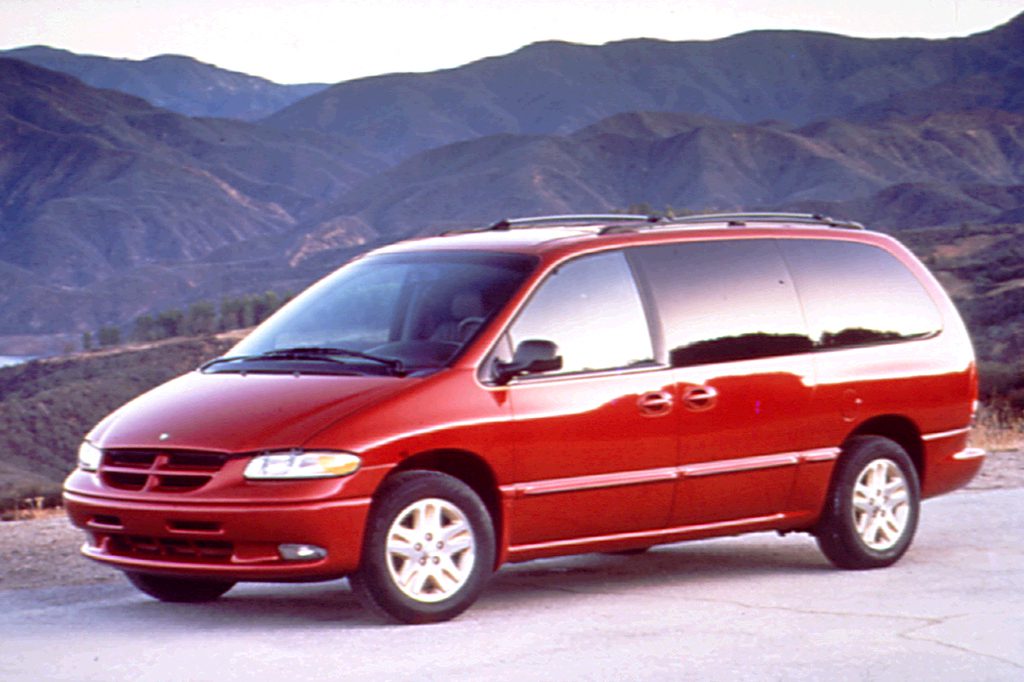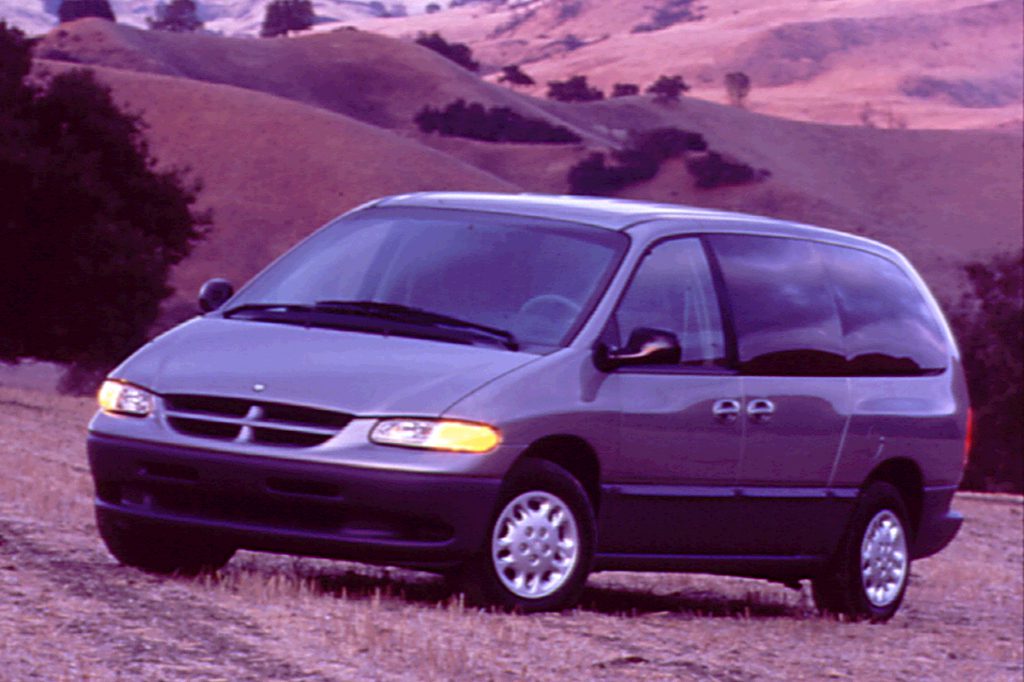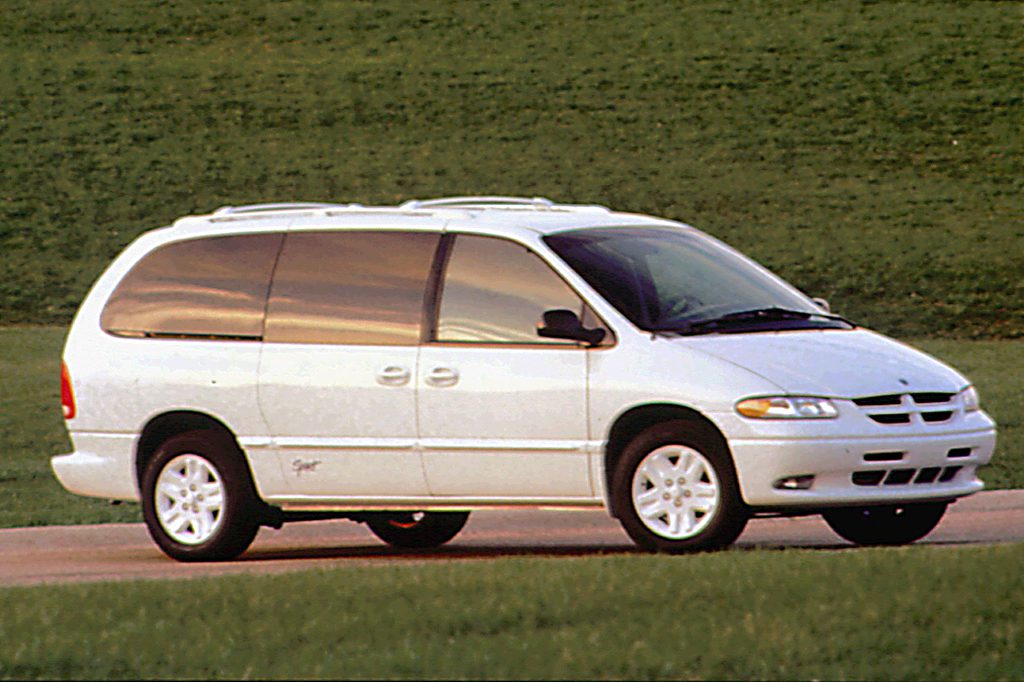| Standard Equipment |
| regular length Base : 2.4-liter dohc 4-cylinder engine, 3-speed automatic transmission, dual front airbags, power steering, sliding driver-side door, 5-passenger seating, cloth reclining front bucket seats, 3-passenger second row bench seat, cupholders, variable intermittent wipers, variable intermittent rear wiper/washer, AM/FM/cassette, digital clock, front map lights, visor mirrors, dual outside mirrors, 205/75R14 tires, wheel covers |
| Grand Base adds: 3.0-liter V6 engine, 4-speed automatic transmission, front air conditioning, 7-passenger seating, front bucket seats, passenger-side underseat storage, 2-passenger second row bench seat, folding 3-passenger rear bench seat, rear floor silencer |
| SE adds: 3.3-liter V6 engine, antilock brakes, tilt steering column, cruise control, 7-passenger seating w/third row bench seat, front seat cargo net, heated power mirrors, power windows, power door locks, tachometer, illuminated visor mirrors, rear defogger, windshield wiper de-icer, deluxe sound insulation, floormats, 215/65R15 tires, 4-wheel disc brakes, load-leveling suspension |
| Sport adds: 3.8-liter V6 engine, permanent all-wheel drive, 4-wheel disc brakes, leather-wrapped steering wheel w/radio controls, deep-tinted glass, fog lights, rear spoiler, load-leveling suspension |
| LE adds to SE: dual-zone manual climate control, 8-way power driver seat w/manual lumbar adjustment, overhead console (sunglass storage, trip computer, compass, outside temperature indicator), AM/FM/cassette w/CD changer controls and Infinity sound system, remote keyless entry, automatic headlights, deep-tinted glass, AWD models add: permanent all-wheel drive, 3.8-liter V6 engine, 4-wheel disc brakes, load-leveling suspension |
| ES adds: 3.8-liter V6 engine, Autostick 4-speed automatic transmission, traction control, leather-wrapped steering wheel w/radio controls, AM/FM/cassette/CD player, automatic day/night rearview mirror and driver-side mirror, universal garage door opener, fog lights, rear spoiler, sport suspension, full-size spare tire, 215/60R17 tires, alloy wheels, AWD models add: permanent all-wheel drive, 4-wheel disc brakes, load-leveling suspension, 215/65R16 tires |
| Optional Equipment |
| Option Note: |
| Major Packages |
| Option |
Avail. |
Retail |
Dealer |
| Pkg. 25T/26T/28T |
w/2.4-liter engine |
$1275 |
$1084 |
| Mfr. Disc. |
|
0 |
0 |
| Pkg. 25T/26T/28T |
w/3.0- or 3.3-liter engine |
1275 |
1084 |
| Mfr. Disc. |
|
515 |
438 |
| Air conditioning, 7-passenger seating, underseat storage drawer, rear floor silencer. |
| Value Plus V6 Group |
Base |
1170 |
995 |
| Mfr. Disc. |
|
670 |
570 |
| Tilt steering wheel, cruise control, power mirrors and windows, power door locks, deluxe interior door trim. Regular length Base requires Pkg. 25T/26T/28T |
| Sport Pkg. 25E/28E |
SE |
1205 |
1024 |
| Mfr. Disc. |
|
930 |
790 |
| Leather-wrapped steering wheel, fog lights, bodyside moldings, rear spoiler, deep-tinted glass, heavy-duty suspension, stabilizer bars, 215/65R16 tires. |
| Sport Pkg. 25N/28N |
SE |
2650 |
2253 |
| Mfr. Disc. |
|
2275 |
1934 |
| Pkg. 25E/28E plus quad bucket seats, 8-way power driver seat w/manual lumbar support, upgraded upholstery, overhead console w/trip computer, second row reading lights. |
| Pkg. 29N |
Sport |
1445 |
1228 |
| Mfr. Disc. |
|
1345 |
1143 |
| Quad bucket seats, 8-way power driver seat w/manual lumbar support, upgraded upholstery, overhead console w/trip computer, second row reading lights. |
| Value Plus Group |
LE |
1235 |
1050 |
| Mfr. Disc. |
|
235 |
200 |
| Rear air conditioning, rear heater, 7-passenger seating w/quad bucket seats. |
| Value Plus Group, ES |
|
1320 |
1122 |
| Mfr. Disc. |
|
320 |
272 |
| Rear air conditioning, rear heater, 7-passenger seating w/quad bucket seats, theft-deterrent system w/alarm. |
| Climate Group II |
Base |
450 |
383 |
| Deep-tinted glass. Requires option pkg. |
| Value Plus Climate Group |
SE |
450 |
383 |
| Mfr. Disc. |
|
0 |
0 |
| Deep-tinted glass, wiper de-icer. |
| Climate Group III |
Grand SE |
780 |
663 |
| Climate Group III |
Sport, Grand SE w/Sport Pkg. 25E/28E |
715 |
608 |
| Climate Group III |
SE w/Sport Pkg. 25N/28N |
520 |
442 |
| Rear air conditioning and heater with dual zone controls, deep-tinted glass (SE), overhead console w/trip computer. |
| Loading Group |
SE, LE FWD |
195 |
166 |
| Full-size spare tire, heavy load/firm ride suspension. SE requires option pkg. |
| Trailer Tow Prep Group |
Grand SE FWD, LE FWD |
435 |
370 |
| Trailer Tow Prep Group |
LE AWD |
365 |
310 |
| Trailer Tow Prep Group |
SE w/Sport Pkg., Sport |
300 |
255 |
| Trailer Tow Prep Group |
ES |
175 |
149 |
| Loading Group plus trailer wiring harness, heavy-duty alternator, battery, radiator, brakes, and transmission oil cooler. Grand SE FWD requires option pkg. |
| Wheel/Handling Group |
LE FWD |
510 |
434 |
| Front and rear stabilizer bars, heavy-duty suspension, 215/65R16 tires, alloy wheels. |
| Powertrain |
| Option |
Avail. |
Retail |
Dealer |
| 3.0-liter V6 engine |
reg. length Base |
800 |
680 |
| Requires 4-speed automatic transmission, option pkg. Not available in California, New York, or Massachusetts. |
| 3.3-liter V6 engine |
reg. length Base |
970 |
825 |
| 3.3-liter V6 engine |
Grand Base |
170 |
145 |
| Regular length Base requires option pkg., 4-speed automatic transmission. |
| 3.8-liter engine w/traction control |
LE |
510 |
434 |
| Mfr. Disc. |
|
460 |
391 |
| 4-speed automatic transmission |
reg. length Base |
200 |
170 |
| Requires V6 engine. |
| Traction control |
FWD LE |
175 |
149 |
| Safety |
| Option |
Avail. |
Retail |
Dealer |
| Antilock brakes |
Base |
565 |
480 |
| Two integrated child seats |
SE, Sport, LE, ES |
225 |
191 |
| Two integrated child seats |
Base |
235 |
200 |
| Includes reclining middle bench seat and integrated child seats. Base SWB and SE require option pkg. |
| Comfort & Convenience Features |
| Option |
Avail. |
Retail |
Dealer |
| Convenience Group I |
Base |
435 |
370 |
| Cruise control, tilt steering column, power mirrors. Requires option pkg. |
| Convenience Group II |
Base |
750 |
638 |
| Convenience Group I plus power door locks. Requires option pkg. |
| Convenience Group III |
Base |
1120 |
952 |
| Convenience Group II, plus power door locks, power windows and rear quarter vent windows. Requires option pkg. NA AWD. |
| Convenience Group IV |
SE, Sport |
240 |
204 |
| Remote keyless entry, illuminated entry, delay-off headlights. SE requires option pkg. |
| Convenience Group V |
SE, Sport |
390 |
332 |
| Convenience Group V |
LE, ES |
150 |
128 |
| Convenience Group IV (SE) plus theft-deterrent system w/alarm. Requires option pkg. |
| Air conditioning |
regular length Base |
860 |
731 |
| Sliding driver-side rear door |
reg. length Base |
595 |
506 |
| Requires option pkg. |
| Rear defogger |
Base |
195 |
166 |
| Includes heated outside mirrors, windshield wiper de-icer. |
| AM/FM/cassette/CD |
LE |
310 |
264 |
| AM/FM/cassette/CD |
SE, Sport |
720 |
612 |
| Requires option pkg. Includes 10-speaker Infinity sound system. |
| Value Plus Audio Group |
SE, Sport |
720 |
612 |
| Mfr. Disc. |
|
270 |
229 |
| AM/FM/cassette/CD player w/10-speaker Infinity sound system. |
| 7-passenger seating |
regular length Base |
375 |
319 |
| 2-passenger middle bench seat, 3-passenger rear bench seat. |
| 7-passenger seating w/quad bucket seats |
SE, Sport |
695 |
591 |
| Front and middle reclining bucket seats, 3-passenger reclining rear bench seat with headrests. |
| 7-passenger seating w/quad buckets and integrated child seat |
SE, Sport, LE, ES |
820 |
697 |
| 7-passenger seating w/quad buckets and integrated child seat |
SE w/Pkg. 25N.28N, LE/ES w/Value Plus Group |
125 |
106 |
| Leather upholstery |
LE |
890 |
757 |
| Leather upholstery |
ES |
1245 |
1058 |
| ES includes power passenger seat. Requires Climate Control Group III and 7-passenger seating w/quad bucket seats. |
| Heated front seats |
ES |
250 |
213 |
| Requires leather upholstery. |
| Smoker’s Group |
|
20 |
17 |
| Cigarette lighter, ashtrays. |
| Appearance and Miscellaneous |
| Option |
Avail. |
Retail |
Dealer |
| Load-leveling suspension |
LE FWD, ES FWD |
290 |
247 |
| Roof rack |
Base, SE, Sport, LE, ES |
215 |
183 |
| Body-colored roof rack |
ES |
260 |
221 |
| Engine block heater |
|
35 |
30 |
| Candy-apple-red metallic paint |
SE, LE, ES |
200 |
170 |
| White-pearl paint |
ES |
200 |
170 |
| Full-size spare tire |
Base, SE, LE |
110 |
94 |
| 15-inch alloy wheels |
SE w/option pkg. |
415 |
353 |
| 16-inch alloy wheels |
LE |
415 |
353 |
| 16-inch alloy wheels |
SE w/option pkg., Sport |
265 |
225 |
| Special Purpose, Wheels and Tires |
| Option |
Avail. |
Retail |
Dealer |
| 17-inch alloy wheels |
SE |
475 |
404 |
| Includes 215/60R17 tires. Requires Sport Pkg. 25N/28N. |





